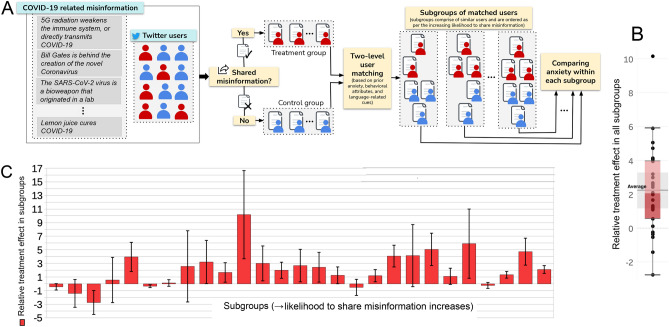Figure 1.
Causal inference methodology (A) and the effect of sharing misinformation on experiencing anxiety—overall distribution (B) and subgroup-wise values (C). We illustrate our methodology to study the causal effect of sharing misinformation (treatment) on experiencing heightened anxiety (outcome) (A). We identify users who shared considerable COVID-19 misinformation on Twitter and assign them to the treatment group, while assigning the ones who did not share any misinformation to the control group. We then employ a two-level matching strategy to identify similar users across the two groups, using several factors like prior anxiety, other prior mental health indicators, platform-specific behavioral attributes, and language-related cues. Within each subgroup of matched users, we compare the aggregate anxiety levels of treatment and control users using their post-treatment Twitter posts to estimate the effect of sharing misinformation. In B, we show a box and whisker plot of relative treatment effect across all subgroups. The average, first and third quartiles, and the confidence interval all lie above 0. The relative treatment effect in each subgroup and the 95% confidence interval are shown in C. Values that are indicate a positive effect of sharing misinformation on anxiety within that subgroup. The subgroups are ordered as per the increasing likelihood of sharing misinformation (propensity scores). Regardless of the likelihood to share misinformation, in most subgroups, users who shared misinformation experienced exacerbated anxiety when compared to similar users who did not share misinformation.

